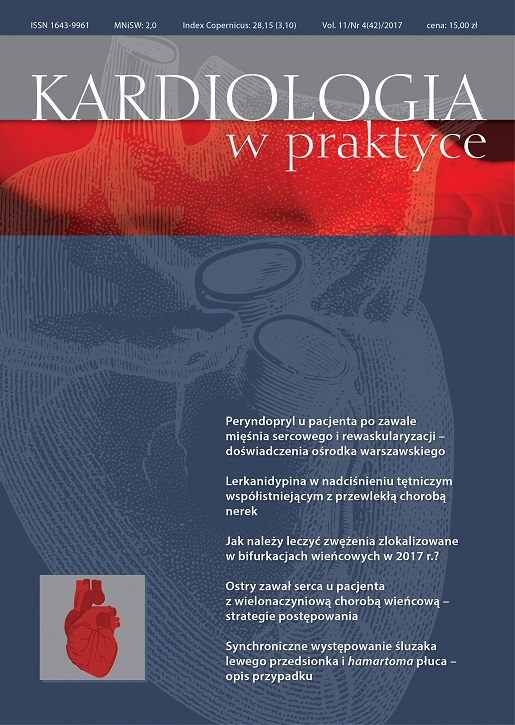Perindopril in a patient after myocardial infarction and revascularization – experience of the Warsaw center Case report
Main Article Content
Abstract
A 56-year-old patient, not treated previously for cardiac conditions, came into the emergency department because of chest pain with left hand numbness. Acute myocardial infarction was diagnosed based on ECG and clinical symptoms. Patient was immediately transferred to cath lab for emergency revascularization. Coronary angiogram revealed critically narrowed marginal branch and tight stenosis of proximal left anterior descending artery. Successful primary angioplasty of the marginal branch with everolimus-eluting stent implantation was performed, followed by second stage elective angioplasty of left anterior descending artery. At the same time, patient was started on antiplatelet agents, a statin, β-blocker and converting enzyme inhibitor. Perindopril was selected, as it was proven to be beneficial for patients after myocardial infarction and revascularization. The patient was referred for an early structured cardiological rehabilitation program.
Downloads
Article Details

This work is licensed under a Creative Commons Attribution-NonCommercial 4.0 International License.
Copyright: © Medical Education sp. z o.o. This is an Open Access article distributed under the terms of the Attribution-NonCommercial 4.0 International (CC BY-NC 4.0). License (https://creativecommons.org/licenses/by-nc/4.0/), allowing third parties to copy and redistribute the material in any medium or format and to remix, transform, and build upon the material, provided the original work is properly cited and states its license.
Address reprint requests to: Medical Education, Marcin Kuźma (marcin.kuzma@mededu.pl)
References
2. Windecker S., Kolh P., Alfonso F. et al.: Wytyczne ESC/EACTS dotyczące rewaskularyzacji mięśnia sercowego w 2014 roku. Kardiol. Pol. 2014; 72: 1253-1379.
3. Fox K.M., Bertrand M.E., Remme W.J. et al.: Efficacy of perindopril in reducing risk of cardiac events in patients with revascularized coronary artery disease. Am. Heart J. 2007; 153: 629-635.
4. The PREAMI investigators: Effects of angiotensin-converting enzyme inhibition with perindopril on left ventricular remodeling and clinical outcome. Results of the randomized Perindopril and Remodeling in Elderly with Acute Myocardial Infarction (PREAMI) study. Arch. Intern. Med. 2006; 166: 659-666.
5. Bertrand M.E., Fox K.M., Remme W.J. et al.: Angiotensin-converting enzyme inhibition with perindopril in patients with prior myocardial infarction and/ or revascularization: a subgroup analysis of the EUROPA trial. Arch. Cardiovasc. Dis. 2009; 102: 89-96.
6. Authors/Task Force Members: Roffi M., Patrono C., Collet J.P. et al.: 2015 ESC guidelines for the management of acute coronary syndromes in patients presenting without persistent ST-segment elevation. Task Force for the management of acute coronary syndromes in patients presenting without persistent ST-segment elevation of the European Society of Cardiology (ESC). Kardiol. Pol. 2015; 73: 1207-1294.
7. Levine G.N., Bates E.R., Blankenship J.C. et al.: 2015 ACC/AHA/SCAI focused update on primary percutaneous coronary intervention for patients with ST-elevation myocardial infarction: an update of the 2011 ACCF/AHA/SCAI guideline for percutaneous coronary intervention and the 2013. ACCF/AHA guideline for the management of ST-elevation myocardial infarction. J. Am. Coll. Cardiol. 2016; 67: 1235-1250.

